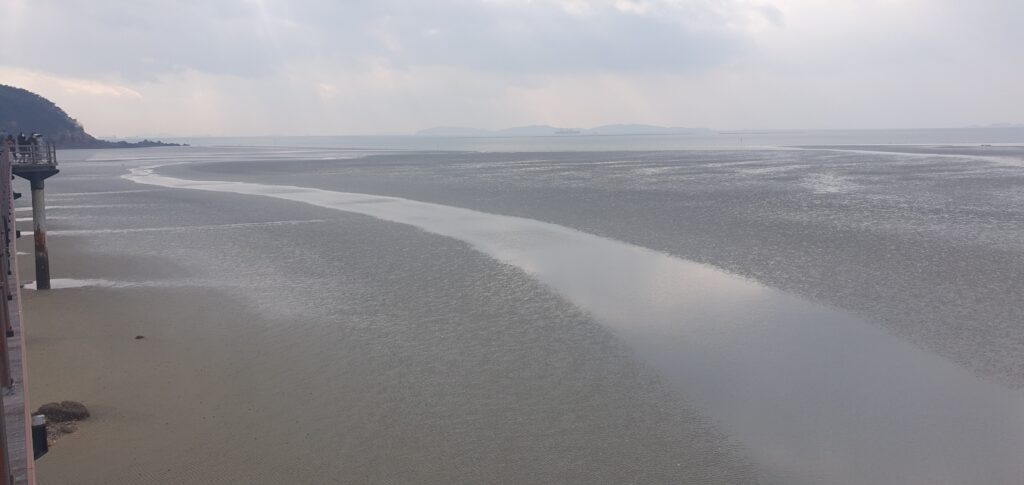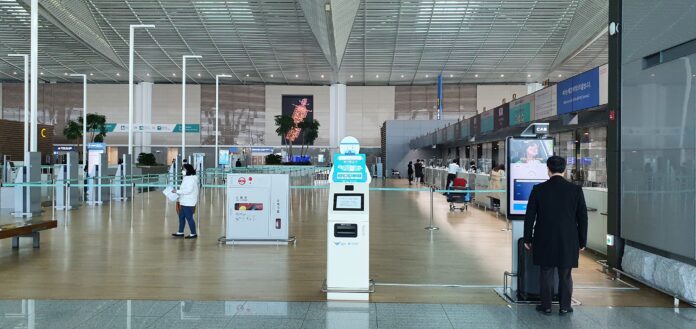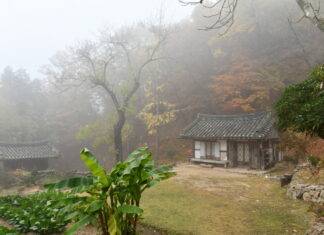Getting Around
The quarantine had begun. My family had set up a quarantine room for me to stay. I figured the quarantine would be a good way to get over jet lag and the refrigerator was stocked with all my favorite food. I soon got a call from the health department.
The tracking app on the iPad was not working. It still showed be at the airport and the tracking device could not be modified. Fortunately, my family had an extra smart phone and they were able (working on the phone with the guy from the health department) to down load the tracking app and get it working. I did not speak enough Korean to accomplish this, but the wife and family came through.
Once I had a working app, you were required to enter data into it several times a day. I required your temperature, note of any cough or other issues. It said if you temperature was above 37.5 degrees centigrade you had to report it. Of course 37.5 degrees centigrade is 98.6 degrees Fahrenheit, which is perfectly normal. So there was no room for error. The next morning I had to report to the district (gu) health office for a PCR test.
The local government had set up a tent city testing site near our home. Here again were more issues. They wanted you to scan a QR code that didn’t work on my phone. Fortunately, my wife came with me as no one at the site spoke English. She was able to have them enter my data manually and sent the test results to her phone and this worked. Another negative test result for me.
Upon returning home we got a call from the health department asking why the phone had left the quarantine location. My wife explained (in Korean) that we had to go for the mandatory arrival PCR test. That satisfied them. None of the PCR test required by the local government cost me any money so that was good.
I now settled in for ten days at home in quarantine. Every six hours or so the app would turn from blue to red indicating another entry was required. If the phone did move for a long time the health department could call to see if you were at the quarantine location of just left the phone there. Fortunately, there was plenty of great food, NETFLIX, and three good books I had brought along to read.
About two days into the quarantine, a box arrived at the door. This was my government issued quarantine survival kit. It had hazardous was trash bags, KN-94 masks, a thermometer, safety instructions (in Korean of course), and food. The food consisted of cans of spam (called lunch meat), microwavable rice, bean and curry pouches, and seaweed (kim). This was a nice supplement to the food already stocked at home and the delivery services so readily available in Korea. The thermometer made the temperature reading entered into the app much more accurate.
Now I’ve seen all I want on NETFLIX and my three books have all been read. It is nine days into the quarantine and time for another PCR test. Down to the tent city I went with exactly the same issues as last time. Again the wife came through and the next morning my negative test results were sent to the phone. My quarantine would end at noon. At 1100 o’clock the health department called to let me know I still had an hour of quarantine left. At noon I was free; however, the app still wanted me to check in. The only solution was to delete the app from the phone. I was now free to move about the country.
One of the first things you notice is how good the mask discipline is in Korea. Everyone wears the KN-94 masks and you never see anyone without one. I guess Koreans are used to it because they routinely wear them during periods of “Yellow Dust” and industrial pollution. I had a great supply of masks and was ready to go. Little did I realize that I still had a lot to learn.
Now that I’m free you want to go to restaurants, markets, and stores. The most interesting restrictions were at restaurants. What I found was the more upscale the restaurant or shop, the tighter the restrictions. At your local mom and pop restaurant, they would check you vaccine card and use a hand held thermometer to take you temperature.
You would then add you phone number to a resister in case they had to trace you. I had a U.S. Center for Disease Control (CDC) vaccine card. Most places I went never saw one but accepted it to be polite. As you went to fancier places they would have thermometers that looked like mobile phones. They would have a face outline on the screen that you would line up on then it would take your temperature.
These were very accurate compared to the hand held one. They would also check your vaccine card. Most Koreans has QR codes with their vaccine status on them. I did not have one so had to use the CDC issued paper card. This proved to be a problem at some higher end restaurants.
Some that will remain nameless (Intercontinental Hotel) refused to accept the CDC card. They would only take an updated QR code on the phone. To solve this some family friends took up to the local health department office. After waiting for an hour or so they transcribed our U.S. CDC card onto a Korean CDC card. This functioned as well as the phone QR code and was accepted everywhere.
While mom and pop places had hand written sheets for customer tracking, many use another procedure. When you went to the restaurant, you were met at the door and they checked you vaccine card. Then they pointed to a sign with a number to call. You called that number and it added you mobile phone number to a tracking data base. So if any COVID cases occur at the facility, they know who has dined there and can contact them for testing.
Another restriction was the number of people at a table. When I was there they said no more than four people can sit at a table. Later it was reduced to three. Now I hear it is up to six. This adversely impacted our ability to get folks together for a birthday party we had planned. We wound up sitting groups of people at separate table. It was a big wet blanket on the festivities.
What is ironic is that the subways are as crowded as ever. So you leave the restaurant with you three friends in you COVID pod and get on the subway with hundreds of strangers. Still, the government says no COVID cases can be traced to the subway. I sure that would be hard to do and the subway is essential to economic life in Korea.
Despite all the restriction, it was still a great visit. I got to see my family and friends. Everyone was very kind and very helpful. Though numerous shops had closed because of the pandemic, there were still plenty open and you still got the flavor of the country. Time passed and it was now time to head back to the States.




Getting Home
When I made my return flight reservations, I picked a weekend flight. Little did I know that they would change the COVID testing time period from 72 hours to one day. The next challenge was to get my preflight COVID test. My first thought was to try the government testing, but, had learned through the health department when I was getting my Korean vaccine card, that the government testing was not valid for overseas travel.
My next though was to use one of the many fine hospitals in the area. I had the family check but none would do the test on weekends for outpatients. This left the airport testing facility as my next best option. The annoying thing was that Incheon was an hour’s drive away. That meant going there, testing, coming home, and going back the next day for the flight. The key to the new policy the U.S. initiated because of Omicron was the test was one day not 24 hours. This means as long as it was one calendar day before the flight you were O.K.
So we looked up the airport testing sites on the internet. Found one site at each terminal. Called and made and appointment. My brother gave me a ride up there with the wife and I got a PCR test at 1100 o’clock. They said they would text the results to my phone and send me a pdf to my email. The test cost $150. We then went to a coffee shop near the airport (most shops in the terminal at Incheon are closed).
Grabbed a snack then went to some beautiful costal islands nearby. Among them was Muuido. Here we hiked around the Muuido Island Sea Tour Trail for a few hours. Then went to the island of Shilmido where South Korea trained spies to infiltrate North Korea in the 1960’s (there we a good movie made about this). It is now a beach resort.
When the negative test results came to the phone after about four hours we had accomplished the mission and we headed home. At home we found the pdf in my email and printed a few hard copies of the test results for the trip home.
While at home I went into my airlines app and filled out my vaccination certification. I had previously down loaded and printed a copy, but the airline wanted it done on line as well. Now it was time to head to the airport. We arrived four hours early and the airline counters were closed as usual. Incheon looked like a ghost town. Arrival and Departure screens were only 25% full. Few if any shops were open outside the secure area. Before the counter open airline personnel came out to the few people waiting and checked there COVID tests and verified that the vaccine certification app had been completed. They then put a color coded sticker on your passport indicating what checks had been made to facilitate the rest the check in process. When the counter opened up, check in when as normal as did security and immigration with one note: all facilities were operating at only 20% of capacity and there were no real lines.
After immigration was cleared, I notice that all the duty free shops were open, but, empty due to the limited number of passengers transiting the airport. There was nowhere to eat; however, my dear wife had backed me a sandwich and there was a convenience store open to get a soft drink and some cookies. I ate my sandwich lowering my mask between bites as I hid out at a deserted gate. The flights were on time and 12 hours after departure I was back in Atlanta.
At Atlanta there was the usual immigration line. No one asked for COVID tests or any questions about vaccine status. Folks did remain masked. Back at the domestic terminal some, but not all, the restaurants were open and the airport was crowded. I caught the flight home. Just missed and ice storm. It is always good to get back home after a long trip.
I frequently talked with my wife about whether the various COVID challenges made the trip to difficult. We both agreed that they were a pain. How necessary the measures were is for others to decide. However, my view is everything you do in life has some element of risk in it including doing nothing.
We took all necessary precautions and were lucky enough to have suffered no ill consequences. It was so great seeing the family and that made the whole expense and hassle worthwhile. Still, if we had known at the start how much hassle it would by, would we have gone? I will answer that next time the issue comes up. Let us all hope that the pandemic burns itself out like all pandemics do. Until then, we will manage risk and keep on living.
By William Harlow











